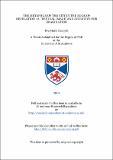The metaphor of the city in the Book of Revelation : a ̀textual image' and incentive for imagination
Abstract
The Metaphor of the City in the Book of Revelation A 'Textual Image' and Incentive for Imagination And I saw the city, the holy one, the New Jerusalem, coming down out of heaven from God, prepared as a bride, made beautiful for her husband. And I heard a great voice from the throne saying: "See, the home of God is among human beings, he will live with them and they will be his people and he himself, God, will be with them and be their God. (Rev 21:2-3) Throughout history, the vision of a new city, the heavenly Jerusalem coming down from heaven has inspired human beings to dream about community, society, the world. It has been an incentive to turn unsatisfied longing into utopian idea and ultimately action. The fact that the language of the Apocalypse can inspire human imagination in a highly effective manner certainly contributed to the book's controversial role in the history of New Testament interpretation. The bizarre, often- paradoxical language seems to veil rather than reveal its message. Interestingly, the book never ceased to be an inspiration for artists. It is the thesis of this study that the text embedded world of the Apocalypse can impel the reader or audience into a new understanding of world and cosmos in a manner similar to visual arts. In contrast to conceptual language, art does not confine interpretation but opens space for imagination. Using artistic expression as paradigm therefore offers considerable insights regarding the striking language in the Apocalypse. In this context, a central image, the city as it appears most prevalent in Rev 1:19-3:22; 17:1-18:24 and 21:1- 22:5 is analysed as metaphorical material, which carries the power to incite the reader/audience to create mental images. To imagine provides a vital step in a dynamic interpretive process of understanding in which significant aspects of the metaphor of the city become textual visuality.
Type
Thesis, PhD Doctor of Philosophy
Collections
Items in the St Andrews Research Repository are protected by copyright, with all rights reserved, unless otherwise indicated.

